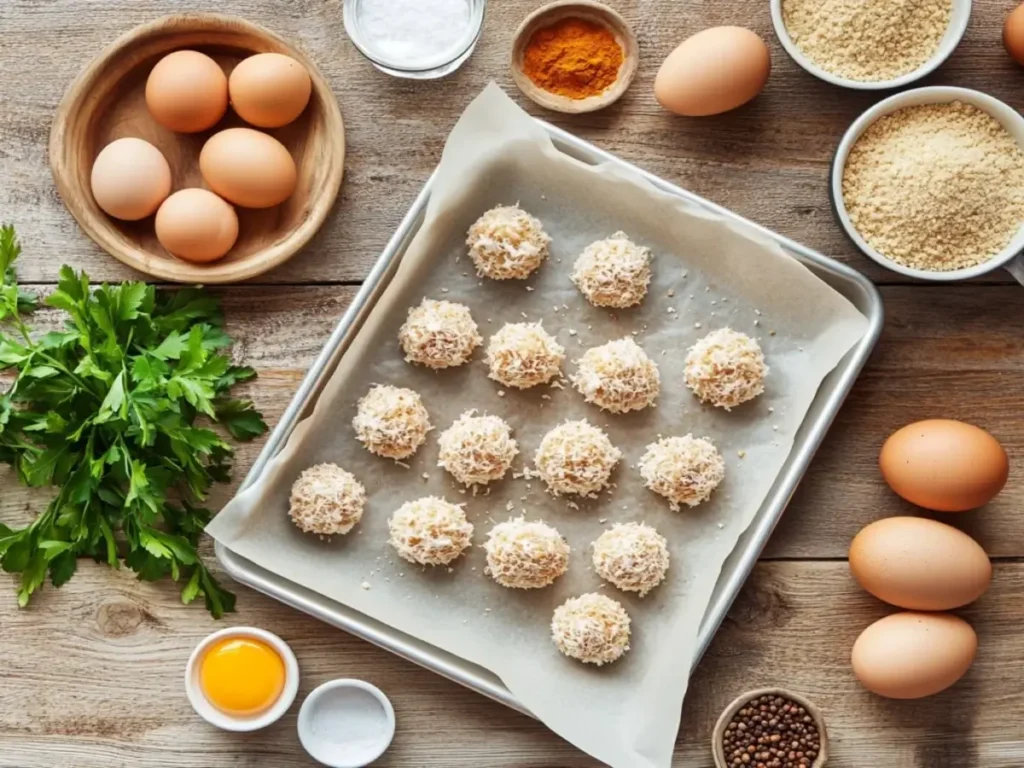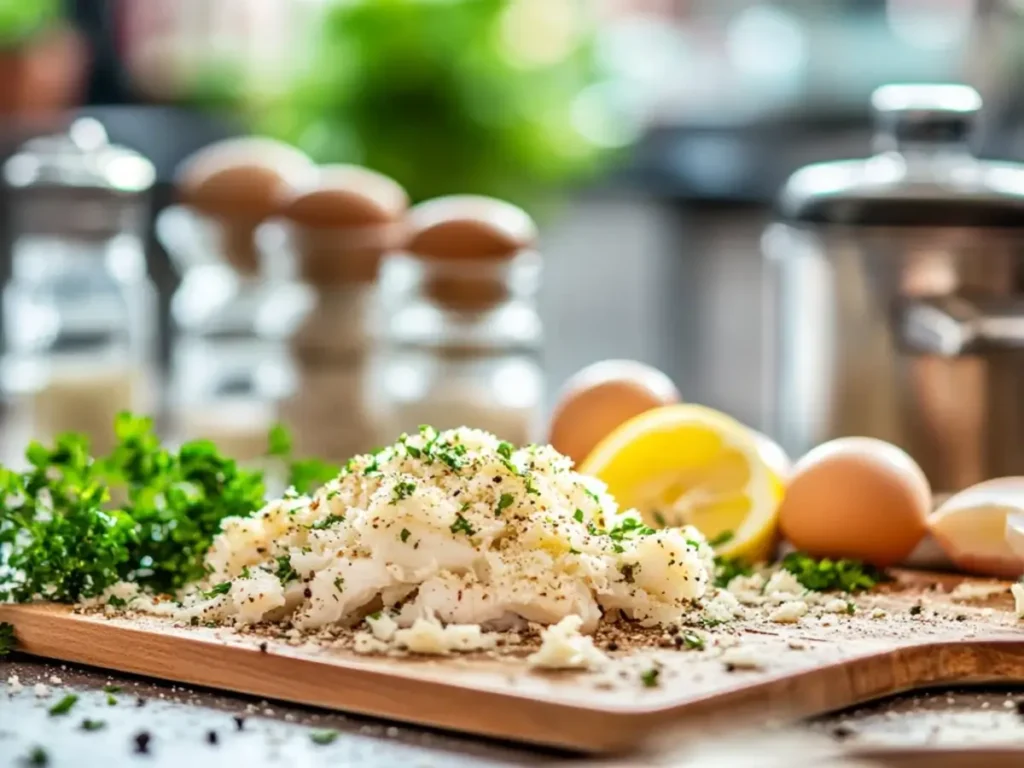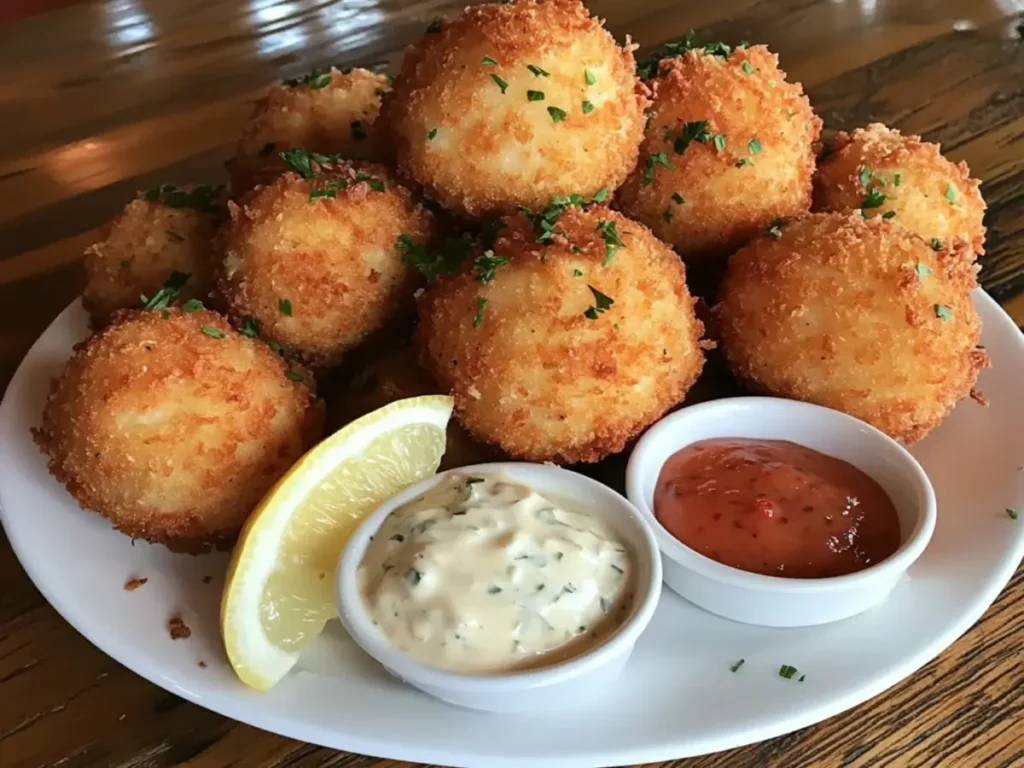Crab balls recipe are a seafood treat loved by many for their rich flavor and satisfying texture. These small, bite-sized delights are perfect for appetizers, party snacks, or even as part of a main meal. But what exactly goes into making crab balls? From the fresh crab meat to the carefully chosen seasonings, each ingredient plays a vital role. Let’s break it down step by step and uncover the secrets behind these savory bites.
Table of contents
Main Ingredients in Crab Balls
For more insights on crafting the ultimate crab balls, check out this ultimate crab balls recipe.
The Star Ingredient: Crab Meat
The most crucial component in crab balls recipe is, unsurprisingly, crab meat. The type of crab meat you choose can significantly affect the taste and texture. Here are the common options:
- Lump Crab Meat: Known for its large, tender pieces and delicate flavor. It’s often used for premium dishes like crab cakes and crab balls where the meat’s natural sweetness shines.
- Claw Meat: Darker and slightly stronger in flavor, claw meat is a great option for those who enjoy a richer taste. It is more affordable and pairs well with bolder seasonings.
- Canned Crab Meat: A convenient alternative when fresh crab isn’t available. While it may lack the sweetness and texture of fresh crab, it’s still a good choice for those seeking simplicity and ease.

Binding Ingredients
Crab balls need a structure that holds their shape without falling apart. To achieve this, certain ingredients are essential:
- Breadcrumbs: Breadcrumbs are the backbone of the mixture, providing structure and absorbing excess moisture. Options include plain breadcrumbs, panko for a lighter texture, or gluten-free crumbs for dietary needs.
- Eggs: Eggs act as a natural glue, binding the mixture together and ensuring the crab balls maintain their form during cooking. Typically, one egg is sufficient for every pound of crab meat.
Flavor Enhancers
What makes crab balls recipe so flavorful is the seasoning and additional ingredients. These amplify the natural taste of the crab without overpowering it:
- Old Bay Seasoning: This iconic seasoning is a must for authentic Maryland-style crab balls. Its blend of spices, including paprika, celery salt, and pepper, perfectly complements seafood.
- Mustard and Mayonnaise: Mustard adds a tangy sharpness, while mayonnaise provides creaminess and keeps the mixture moist. Dijon mustard is a popular choice for an extra layer of depth.
- Fresh Herbs: Chopped parsley, dill, or even chives brighten the dish and add a hint of earthiness. They
- Lemon Juice: A splash of fresh lemon juice cuts through the richness and enhances the overall flavor profile.
Step-by-Step Process of Making Crab Balls

Preparing the Crab Meat
To start, inspect the crab balls recipe carefully for any stray shells or cartilage, as these can sometimes be overlooked. Fresh crab meat often contains small fragments that should be removed by hand to ensure a smooth texture. Additionally, handle the meat gently to avoid breaking up the delicate lumps, as these contribute to the final dish’s appeal. If you are using canned crab meat instead, make sure to drain it thoroughly; otherwise, the mixture may become too wet and difficult to shape. By taking these steps early on, you set the foundation for perfectly textured crab balls.
Mixing the Ingredients
In a large mixing bowl, combine the crab meat with breadcrumbs, egg, and your chosen seasonings. Start with a small amount of breadcrumbs and adjust as needed to achieve the right consistency. Use a rubber spatula or your hands to mix the ingredients gently, ensuring the crab remains in chunks rather than being overworked into a paste.
Here’s a basic ratio to follow:
- 1 pound of crab meat
- ½ cup of breadcrumbs (or alternative)
- 1 egg
- 2 tablespoons of mayonnaise
- 1 teaspoon of mustard
- 1 teaspoon of Old Bay Seasoning
Taste the mixture (before adding the egg if you’re concerned about raw ingredients) to ensure the seasoning is balanced. Adjust as necessary.
Shaping the Balls
Once the mixture is ready, scoop out portions using a tablespoon or small cookie scoop. Roll each portion gently between your palms to form a ball about 1 inch in diameter. For consistency, you can weigh the balls to ensure uniform size, which is especially helpful for even cooking. Place the shaped crab balls on a parchment-lined tray and refrigerate for at least 30 minutes. Chilling helps the mixture firm up and reduces the chances of the crab balls falling apart during cooking.
Cooking Methods for crab balls recipe
Crab balls recipe can be prepared using a variety of cooking methods, depending on your preference:
- Frying: Heat about an inch of oil in a skillet over medium heat. Once the oil is hot (around 350°F), fry the crab balls in batches until golden brown, about 2-3 minutes per side. Drain on paper towels to remove excess oil.
- Baking: Preheat your oven to 375°F. Arrange the crab balls on a greased or parchment-lined baking sheet. Brush them lightly with melted butter or olive oil for a golden finish. Bake for 15-20 minutes, turning them halfway through for even browning.
- Air-Frying: Preheat your air fryer to 375°F. Spray the basket lightly with cooking spray. Arrange the crab balls in a single layer, leaving space between each. Cook for 10-12 minutes, shaking the basket halfway through to ensure even crisping.
- Broiling: For an extra crispy crust, broil the crab balls for 2-3 minutes at the end of baking.
Serving Tips

Serve the crab balls immediately while they’re warm and crispy. Garnish with additional parsley or a wedge of lemon for presentation. Pair with a dipping sauce of your choice for added flavor.
Variations of Crab Balls Recipe
Looking for the perfect dessert pairing? Explore the best cream for cream brulle or learn about the difference between creme brulee and custard.
Regional Variations
- Maryland-Style Crab Balls: Heavily seasoned with Old Bay and containing a small amount of mustard, these crab balls are quintessential Chesapeake Bay fare.
- Asian-Inspired Crab Balls: Incorporating flavors like soy sauce, ginger, and sesame oil, these offer a fusion twist that pairs well with sweet chili sauce.
- Cajun Crab Balls: Adding Cajun seasoning and a dash of hot sauce gives these crab balls a spicy Southern flair.
Dietary Alternatives
- Gluten-Free Crab Balls recipe: Substitute breadcrumbs with almond flour or gluten-free panko for a gluten-free option.
- Low-Carb or Keto-Friendly: Use crushed pork rinds or Parmesan cheese as a binder instead of traditional breadcrumbs.
- Dairy-Free: Skip the mayonnaise or use a dairy-free alternative to accommodate dietary restrictions.
Tips for Perfect Crab Balls Recipe
Choosing the Best Crab Meat
- Always opt for the freshest crab meat available. Visit local seafood markets for the best selection.
- If using canned crab, look for lump crab meat with minimal added salt or preservatives. Rinse and drain well to improve the texture.
Balancing Ingredients Crab Balls Recipe
Striking the right balance between moist and firm is key. Overloading the mixture with breadcrumbs can make the crab balls dense and dry, while too little binder may cause them to fall apart during cooking.
Cooking for Texture
If frying crab balls, it’s important to ensure the oil is properly heated to around 350°F (175°C). Using oil at the right temperature will create a crisp, golden exterior while preventing the crab balls from absorbing excess grease, which can make them heavy and unappetizing. A kitchen thermometer is a helpful tool to maintain consistent oil temperature throughout the cooking process.
For baking or air-frying, lightly brushing the crab balls with oil before cooking can help achieve a beautifully golden crust. Arrange them on a parchment-lined baking sheet or in the air fryer basket with space in between to allow for even cooking. Bake in a preheated oven at 375°F (190°C) or air fry at 350°F (175°C) for 10-15 minutes, flipping halfway through, until the crab balls are crisp and cooked through. This method is a great alternative to deep frying, offering a lighter yet equally satisfying result.
Enhancing Flavor
- Add a pinch of cayenne pepper or smoked paprika to give the crab balls a slight kick.
- For a richer flavor, mix in a small amount of grated Parmesan cheese.
- Experiment with fresh herbs like cilantro or basil for unique flavor profiles.
Storing and Reheating
Storing Leftover Crab Balls
Leftover crab balls can be safely stored in an airtight container in the refrigerator for up to three days.
How to Reheat Crab Balls
When ready to reheat, set your oven or air fryer to 350°F (175°C). Arrange the crab balls in a single layer on a baking sheet or in an air fryer basket, ensuring they are spaced apart for even warming.
Heat them for approximately 5-7 minutes, or until they are hot all the way through and the exterior is crisp and golden. Avoid microwaving, as it can result in a soggy texture, diminishing their crunch.
Serving Suggestions
For a finishing touch, garnish with fresh parsley, a wedge of lemon, or your favorite dipping sauce to enhance the flavors.
Making Them Kid-Friendly
Leftover crab balls can be safely stored in an airtight container in the refrigerator for up to three days. When reheating, preheat your oven or air fryer to 350°F (175°C). Arrange the crab balls in a single layer on a baking sheet or in an air fryer basket, leaving space between each piece for even warming. Heat them for 5-7 minutes, or until they are thoroughly warmed and the exterior regains its crisp texture. Avoid using the microwave, as this can result in a soggy consistency.
If serving to kids, consider reducing the amount of spicy seasonings during preparation to make the flavors more child-friendly. Pair the crab balls with milder dipping sauces like ranch dressing or honey mustard, which are often more appealing to younger palates. Additionally, shaping the mixture into smaller, bite-sized portions can make them easier and more fun for little hands to handle. For added presentation, serve with a colorful assortment of veggies or fruit on the side.
Conclusion
Crab balls are a seafood favorite that strike a perfect balance between simplicity and elegance. With the right combination of fresh, quality ingredients and careful preparation, you can create crab balls that are tender, packed with flavor, and utterly satisfying. Whether sticking to a traditional recipe or trying creative variations by incorporating herbs, spices, or unique dips, these bite-sized delights are versatile enough to suit any occasion. Serve them as an appetizer, party snack, or even as part of a main course—either way, they’re guaranteed to please both casual diners and seafood enthusiasts alike.
FAQs
Can I prepare crab balls recipe in advance?
Yes, you can mix and shape the crab balls ahead of time. Store them in the fridge for up to 24 hours before cooking.
What can I use instead of breadcrumbs?
Crushed crackers, almond flour, or gluten-free panko are excellent substitutes.
Are crab balls healthy?
They can be! Baking or air-frying crab balls reduces the fat content compared to frying. Opt for fresh ingredients and balanced seasonings to keep them nutritious.
Can I freeze uncooked crab balls?
Absolutely. Freeze them on a tray first, then transfer to a freezer bag. Cook directly from frozen for best results. Ensure to add a few extra minutes to the cooking time.
What’s the best way to reheat crab balls?
Reheat them in an oven or air fryer to maintain crispness. Avoid microwaving as it can make them lose their texture.
Can I make crab balls without eggs?
es, you can use alternatives like flaxseed meal mixed with water or mashed potatoes as a binder for an egg-free option.
